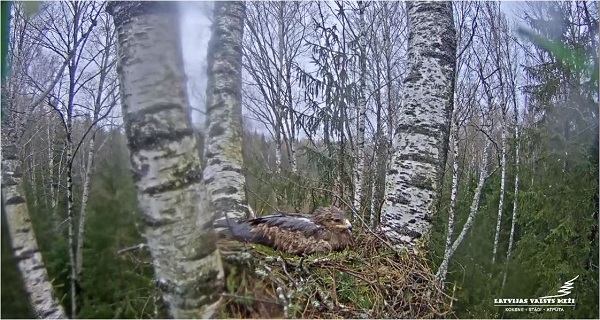Female Eagle Rasa Lays Its Second Egg
In the evening of 1 May, lesser spotted eagle female Rasa laid its second egg in the Aizkuja nest. Although only one young eagle can reach the ability to fly, lesser spotted eagles usually lay two eggs. The second egg is for safety, should the first one die. Both young eagles survive only in very rare cases.
An equally happy event a few days ago was also experienced in the lesser spotted eagle located on the Big Island. There, on the afternoon of 29 April, at 16:50:37, the female bird laid its first egg. This year, the on-line cameras of JSC “Latvia’s State Forests” (LVM) show two nests of lesser spotted eagles, where eggs are currently being hatched.
The majority of lesser spotted eagles have already arrived
It is in April that lesser spotted eagles arrive to nesting areas from their wintering grounds in Africa. The monitoring data of lesser spotted eagles in Latvia’s state forests obtained from six sample plots in different regions of Latvia show that the largest share of eagles have already arrived. Although the weather is cool, eagles are mating and building nests. Lesser spotted eagles are rustling also in two of the three LVM video surveillance nests.
The first eagle arrived in the nesting area of the Big Island on 7 April, the second eagle of the couple arrived on 11 April. Mating could be immediately heard, and the two eagles began to replenish two nearby nests with fresh spruce branches. In turn, in Aizkuja district, which was already observed live last year, both eagles arrived on 12 April and started to inhabit a nearby nest on a birch tree, where common buzzards were successfully nesting last year.
Sometimes the male bird brings a frog to the female bird in the nest, thus showing attention and confirming that there will be enough food to start nesting. According to a joint study carried out by LVM and the University of Latvia, in which we have analysed the food objects brought to the video surveillance nests of lesser spotted eagles, the main feed supplier is the male bird, and frogs are the most important feed animal in spring.
You can follow the events taking place in the six nests by watching the live video: https://bit.ly/3sXQ8Is



